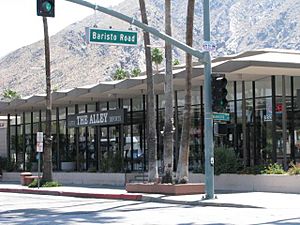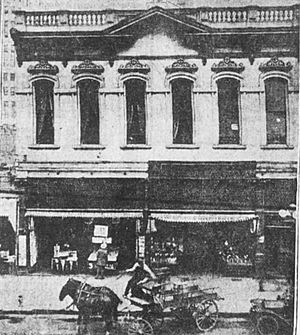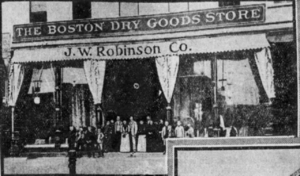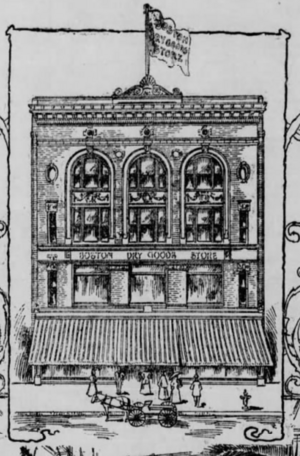J. W. Robinson's facts for kids
| Department store | |
| Industry | Retail |
| Fate | Merged with May Company California |
| Successor | Robinsons-May (1993–2006) Macy's (2006-present) |
| Founded | 1883 |
| Defunct | 1993 |
| Headquarters | Los Angeles, California |
| Products | Clothing, footwear, bedding, furniture, jewelry, beauty products, and housewares. |
| Parent | Associated Dry Goods (1957–1986) The May Department Stores Company (1986–1993) |
J. W. Robinson Co., often called Robinson's, was a well-known chain of department stores. These stores were located in Southern California and Arizona. The company's main office was in Los Angeles, California.
The Story of Robinson's Stores
How It All Started: 1883
Joseph Winchester Robinson was a merchant from Waltham, Massachusetts. In 1882, he moved to Riverside, California to grow oranges. However, he noticed that the local stores didn't offer good quality products or service.
So, Robinson decided to go back into retail. He used his connections on the East Coast to bring better goods to California.
In 1883, Robinson opened his first store. It was called the Boston Dry Goods Store. It was about 1,440 square feet (134 square meters) in size. The store was located in the Allen Block in downtown Los Angeles. Robinson promised "fine stocks and refined 'Boston' service."
In 1891, J. W. Robinson passed away at age 45. His son, Henry Winchester Robinson, came from Boston to take over the business. To honor his father, he renamed the store the "J. W. Robinson Company."
Moving to Spring Street: 1886–1895
In 1887, J.W. Robinson Co.'s Boston Dry Goods Store moved to a new, larger location. This store was about 3,000 square feet (279 square meters). It was in the Jones Block at 171–173 Spring Street. This move was seen as daring because it was far from the main business area at the time.
When Robinson's moved again in 1895, Nathaniel Blackstone took over the old space. He was J.W. Robinson's brother-in-law. Blackstone opened his own store, Blackstone's Dry Goods, which also became a well-known department store.
Mr. C. W. R. Ford, who had his own wholesale store, married Robinson's widow. He then became the president of the Robinson's company.
New Store on Broadway: 1895
Between 1880 and 1890, Los Angeles grew very quickly. Its population doubled from about 50,000 to over 100,000 people. Because of this growth, J. W. Robinson Co. needed more space.
In January 1895, the company, then known as "The Boston Store," announced a new building. A four-story "Boston Dry Goods Store Building" was being built at 239 S. Broadway. This new store was across from the City Hall of that time. It was designed by famous architects Theodore Eisen and Sumner Hunt.
The new store opened on October 1, 1895. It was promoted as a sign that Los Angeles was becoming a major city. People no longer needed to travel to San Francisco to find a wide selection of good merchandise.
The building had a "Grecian" (Greek Revival) style. It was made of light cream brick and terra cotta. It featured large windows and detailed decorations. Inside, it had passenger and freight elevators. The first floor and basement were for shopping, while upper floors held offices and work areas. The second floor had departments for fabrics, a writing desk for customers, and ladies' restrooms.
In 1908, the store added a five-story extension at the back, facing Hill Street.
The Flagship Store on Seventh Street: 1915
As Los Angeles continued to grow, so did Robinson's business. In 1914, the company announced plans for a huge new flagship store. This store would cost $1,000,000 and have seven stories. It would cover an entire block on West Seventh Street. The architects were Frederick Noonan and William Richards.
The new store opened on September 7, 1915. It had over 400,000 square feet (37,161 square meters) of floor space. In 1923, the building was expanded even more, reaching 623,700 square feet (57,944 square meters). In 1934, the building was updated with a "restrained Modernistic" look.
Robinson's became the largest store in a new upscale shopping area on Seventh Street. Other stores like Ville de Paris and Coulter's also opened nearby. The Robinson's store closed in 1993. Today, the building at 600 W. Seventh St. is used for offices and retail.
The store had many different departments:
- First (ground) floor: Ribbons, umbrellas, jewelry, stationery, men's and boys' clothing, and a "bargain square."
- Second floor: Linens, fabrics, ladies' restrooms, and beauty parlors.
- Third floor: Ladies' and misses' clothing, baby shop, children's dresses, hats, sweaters, and corsets.
- Fourth floor: Rugs, draperies, pictures, and toys.
- Fifth floor: Offices, an auditorium, and workrooms.
- Sixth floor: A hospital room and storage.
- Seventh/top floor: Employee cafeteria, outdoor "courts," and lounges.
Growth and Changes: 1950s-1980s
In 1955, a company called Associated Dry Goods (ADG) bought Robinson's. At that time, Robinson's sales were about $32.5 million each year.
Unlike some other department stores, Robinson's didn't open many branch stores in the 1930s and 1940s. They only had a small shop in Palm Springs.

In 1952, Robinson's opened its second store in Beverly Hills. This store was on Wilshire Boulevard. A small, winter-only store followed in Palm Springs. Then, a store opened in Pasadena. This Pasadena store was the last stand-alone store before shopping malls became popular.
The first stores connected to shopping malls opened in Panorama City (late 1950s), Anaheim Plaza, Santa Barbara (1960s), and Glendale. By the time Robinson's merged into Robinsons-May, there were almost 30 stores across Southern California.
Becoming Part of May Department Stores
Associated Dry Goods (ADG) bought Robinson's in 1957. Later, in 1986, May Department Stores bought ADG, which included Robinson's.
In 1989, May Department Stores closed its Goldwaters division in Arizona. Those stores were then rebranded as Robinson's stores.
The End of Robinson's: 1992-2006
In 1992, May Department Stores combined Robinson's with another chain, May Company California. They created a new brand called Robinsons-May. The former Robinson's stores became mid-range department stores. Some people felt they lost their unique identity.
In 2005, Federated Department Stores (which owned Macy's) bought May Department Stores. Robinsons-May was then closed down in 2005–2006. The old Robinson's stores were either closed, sold, or turned into Macy's or Bloomingdale's stores.
Robinson's Store Locations
Here is a list of some Robinson's stores in California and Arizona when they merged in the early 1990s:
| Community | Mall or address | Opened | Notes |
|---|---|---|---|
| California | |||
| Downtown Los Angeles | Seventh, Hope & Grand | September 7, 1915 | This was the main flagship store. |
| Beverly Hills | 9900 Wilshire Bl. (near Beverly Hilton) | February 13, 1952 | This building was later torn down in 2014. |
| Palm Springs | 333 S. Palm Canyon Dr. | January 10, 1958 | Now used as a community center. |
| Pasadena | 777 E. Colorado Blvd. | May 12, 1958 | Now a Target store. |
| Panorama City | Van Nuys at Chase, Panorama City Shopping Center | June 27, 1961 | |
| Anaheim | Anaheim Plaza | February 1963 | Closed in 1988. |
| Glendale | Glendale Fashion Center | August 1966 | |
| Santa Barbara | La Cumbre Plaza | July 1967 | |
| Newport Beach | Fashion Island | September 1967 | |
| San Diego | Fashion Valley Mall | September 1969 | |
| Cerritos | Los Cerritos Center | September 1971 | Became Robinsons-May, then Nordstrom in 2010. |
| Woodland Hills | Woodland Hills Promenade | March 1973 | Later became a Macy's. |
| Puente Hills | Puente Hills Mall | March 1974 | This location was seen in the movie Back to the Future. |
| Westminster | Westminster Mall | April 1975 | Later became a JCPenney. |
| Santa Anita | Santa Anita Fashion Park, Arcadia | April 19, 1976 | Became Robinsons-May, then Forever 21 in 2012. |
| Thousand Oaks | The Oaks | 1978 | |
| UTC (La Jolla, San Diego) | University Towne Center | 1978 | |
| Mission Viejo | Mission Viejo Mall | 1979 | |
| Santa Monica | Santa Monica Place | ||
| Sherman Oaks | Sherman Oaks Galleria | 1980 | |
| Del Amo | Del Amo Fashion Center | ||
| Horton Plaza | Horton Plaza, San Diego | ||
| Escondido | North County Fair | ||
| South Coast Plaza | South Coast Plaza (Crystal Court), Costa Mesa | ||
| Palm Desert | Westfield Palm Desert | Became Robinsons-May, then Sears in 2004. | |
| Santa Ana | MainPlace | ||
| Brea | Brea Mall | May 1991 | Later became a JCPenney. |
| Arizona (All were previously Goldwater's stores) | |||
| Mesa | Fiesta Mall | ||
| Phoenix | Metrocenter Mall | ||
| Phoenix | Paradise Valley Mall | ||
| Phoenix | Park Central Mall | Closed in 1990. | |
| Scottsdale | Scottsdale Fashion Square | ||
Robinson's Beyond California
Robinson's in Japan
Before May Department Stores bought Robinson's, the company worked with Ito-Yokado to create Robinson's Japan. They opened one store in Kasukabe, Saitama. In 2009, this Japanese Robinson's was bought by Seven & I Holdings Co..
Robinson's of Florida
In 1972, Associated Dry Goods (ADG) used the Robinson's name to open a separate group of stores in Florida. These stores, called Robinson's of Florida, were located on Florida's Gulf Coast and in Orlando. ADG wanted to create upscale stores similar to J. W. Robinson's in the growing Florida Gulf Coast area.
This new division grew to 10 locations. May Department Stores sold this division in 1987 to Maison Blanche. Later, some of these Florida Robinson's stores were sold to Dillard's or became Gayfers stores.






